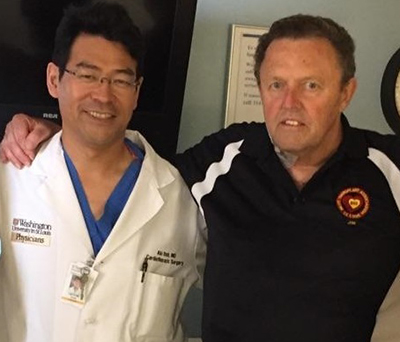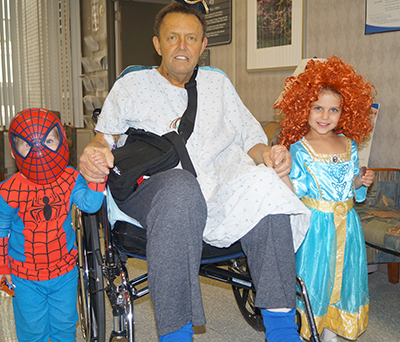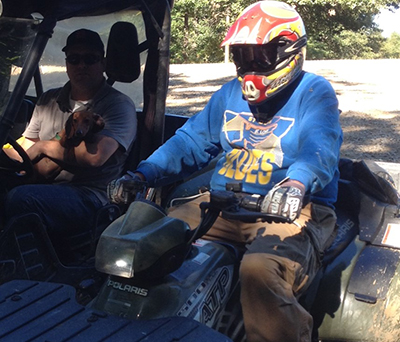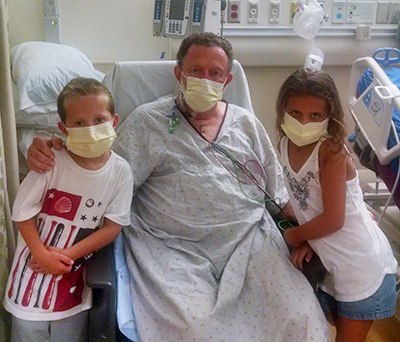James Brooks lives his life to its fullest. No one would ever guess that his family history of heart disease that took the life of his father and younger brother – came close to taking him.

Diagnosed in 2003 with heart failure, he said, “I just continued to live my life. I had three children and a wife. Every day you wake up is a good day.”
In 2012, on what he describes as the worst day of his life, he suffered complete organ failure. He doesn’t remember many details after he arrived at Barnes-Jewish Hospital, but he does remember waking up with an LVAD (left ventricular assisted device) 1 ½ weeks after he was admitted. He spent the next 45 days in the hospital.
After he was released, James worked hard to get back to his active self – LVAD and all. It only took him two weeks to build up his strength to walk without his walker. He said, “Because my kidneys got lazy from laying around the hospital for so long, I needed dialysis three times a week.” Eventually his kidneys started functioning again and dialysis was a thing of the past.

Rehab – his way
James took his rehab program to a whole new level. Instead of running on a treadmill for 30 minutes where “you don’t really accomplish anything”, James decided to rehab his health while he rehabbed his basement – a project he started before he got sick.
So six months after receiving his LVAD, James got back to work on his basement project. “In the beginning, just walking down the basement steps exhausted me. I’d have to sit down and rest for 15 minutes. It took me a year to finish the basement rehab – putting up wall studs, insulation, dry wall and ceramic flooring.”
Life with LVAD
James didn’t let his LVAD slow him down – not even a little. In addition to finishing his basement, he went back to his bowling league, built a treehouse, got under his house to jack up a floor joist, did an engine swap on his son’s jeep, rode four-wheelers on his property, dug a trench to change the heat pump system in his house, and was alive to meet his youngest grandson.
He said, “People would ask me – are you sure you are supposed to be doing that?” His answer was always, “You can do anything with a LVAD. Staying active is the key to having success with the LVAD. You have to learn to wear it comfortably and trust the equipment.”

Lucky night
After living for almost four years with his LVAD, James remembers receiving the call he and his wife had been waiting for – a donor heart was available. They were on their way to the casino, something they didn’t do very often, but that phone call turned his evening into the luckiest night of his life – and he didn’t even have to place a bet.
James arrived at Barnes-Jewish Hospital within the hour, and early the next morning Washington University cardiothoracic surgeon, Akinobu Itoh, MD, gave him his new heart. James was the 800th heart transplant patient at Barnes-Jewish.
Two weeks after his transplant, James was sent home. “Recovering from my heart transplant was like a walk in the park. The LVAD allowed me to get stronger than I had been in the last five years. Plus, it kept me alive. I was back to my normal activities within three months.”
A picture is worth a thousand words
James wants to give hope to other heart patients – LVAD patients and those waiting for a heart transplant. As a volunteer with the Heart Transplant Association, he visits patients every week on the heart floor and shares with them his journey from LVAD to heart transplant patient.

He lets his photobook called “A Bridge to Transplant” tell his personal story. He reassures patients who are worried about their quality of life after LVAD. Through his photos, James shows them that his LVAD didn’t slow him down and it shouldn’t slow them down either.
Dr. Itoh describes with admiration what James does as a volunteer. “Mr. Brooks is amazing. What he does makes a huge difference for our patients and their families. He tells patients everything he went through and what they can expect – the good and the bad. I really appreciate all that he does.”
James visits patients before and after surgery to offer encouragement. He tells them, “I struggled with a lot of difficulties and made it. You can too. You just have to keep pushing forward – being active helps everything.
I’m in better health today than I was 15 years ago.”